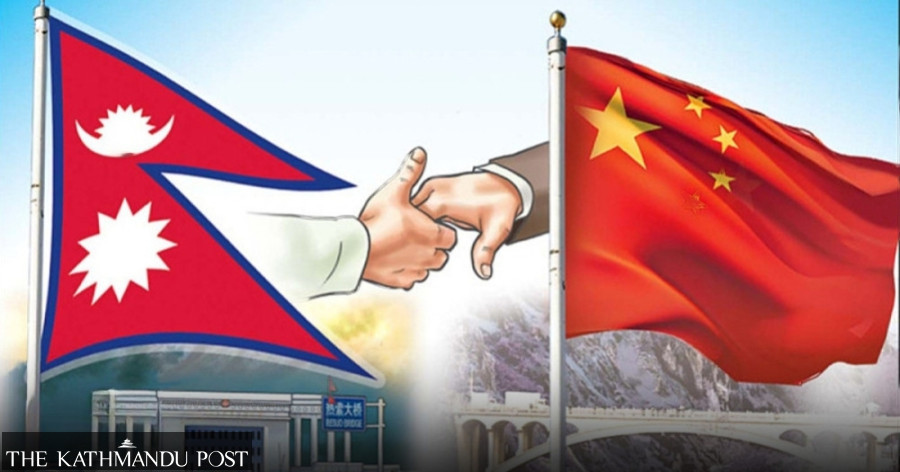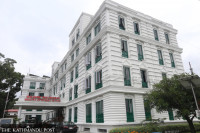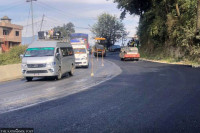National
Nepal to seek action on Chinese pledges at bilateral meeting
Kathmandu is hosting the 16th Nepal-China foreign secretary-level meeting later this month.
Anil Giri
Nepal and China are set to hold the 16th round of Diplomatic Consultation Mechanism talks in Kathmandu later this month. The meeting will likely take place on June 25.
Vice foreign minister of China, Sun Weidong, will visit Kathmandu for the meeting.
Deputy Prime Minister and Minister for Foreign Affairs Narayan Kaji Shrestha said that the meeting will discuss all regular issues between Nepal and China.
“The meeting will mostly discuss and deliberate on issues related to executing past accords and agreements signed during several high-level visits. It will also explore new avenues of cooperation,” Shrestha said.
The 15th meeting was held in Beijing.
As the meeting of the diplomatic consultation mechanism is approaching fast, the Ministry of Foreign Affairs has already held a round of discussion with several line ministries and sought their agendas and inputs on what the Nepali side needs to discuss during the meeting.
Despite some progress made in reopening the traditional bilateral entry points between Nepal and China, delay by the Chinese contractors in expanding and maintaining several road projects, and their tardiness in handing over the detailed project report of the second phase of the Kathmandu Ring Road, have led to setbacks.
Also on the agenda are China’s commitment to importing Nepali goods, amending the Trade and Payment Agreement signed in 1981, and joint inspection of Nepal-China border that has been stalled for over two decades, multiple Nepali officials involved in the preparatory meeting told the Post.
The mechanism, which serves as a high-level forum between Nepal and China, is expected to discuss a wide range of issues, including trade, transit, connectivity, investment, health, tourism, poverty alleviation, disaster management, education, culture, and people-to-people exchanges.
The Nepali side, during Deputy Prime Minister Shrestha’s China visit in March-April, had already proposed elevating the bilateral mechanism from the current foreign secretary-level to that of foreign ministers.
The upcoming meeting is likely to give positive inputs to the government for elevating the current foreign secretary-level mechanism to that of foreign ministers, Rupak Sapkota, foreign relations adviser to Prime Minister Pushpa Kamal Dahal, told the Post.
Officials from both sides are discussing the issues that have been on the table over nearly a decade of bilateral visits. These include the visits of former Prime Minister KP Oli to China in 2016, and later in 2018; the 2019 visit of Chinese President Xi Jinping to Nepal, and the visit of Prime Minister Dahal to China last year.
In the meeting, the Nepali side will raise several issues, such as exporting citrus fruits to China as committed by the Chinese side, exporting Nepali haylage (grass silage) to China, and finalising the protocol for exporting buffalo meat to China.
The meeting will also discuss the export of Nepali tea, coffee, and other agriculture-related projects to China.
A Nepali bureaucrat who has been consulted ahead of the upcoming talks with China, said the Chinese side has been demanding proper certification for vaccines given to buffaloes and confirmation that the buffalo meat is free from foot-and-mouth disease, among other requirements. These demands have caused a delay in exporting processed buffalo meat to China.
The meeting will also discuss the amendment to the Trade and Payment Agreement, Nepal’s perennial trade deficit with China, and several other issues related to tourism, connectivity, expediting China-funded projects in Nepal, agriculture, people-to-people contact, and high-level visits from both sides.
While the Chinese side has yet to share its agenda, according to officials at the Ministry of Foreign Affairs, the Chinese may push for early ratification of the Mutual Legal Assistance agreement signed during the state visit of Chinese President Xi in 2019. The agreement is pending in Parliament. Similarly, another agreement related to boundary management between Nepal and China agreed during the same visit, is also yet to be formalised.
During the visit of Prime Minister Dahal to China in September last year, the two sides had agreed to carry out a joint inspection of the Nepal-China boundary. The Nepali side has completed its preparations and has been calling for joint inspection, but the Chinese side has been reluctant despite previous understandings, a senior official at the Department of Survey told the Post.
The department, through the Ministry of Foreign Affairs, also made several correspondences in this regard, said the official. The 1963 Joint Boundary Protocol has the provision of constituting three different mechanisms for dealing with boundary issues—the Joint Inspection Team, the Joint Expert Group, and the Joint Inspection Committee.
The mechanisms were enshrined in the Nepal-China Boundary Protocol signed between the two countries on January 20, 1963. The Nepal-China border spans 1,439 km. The officials of the two countries have yet to decide whether to resume the work from where it was left in 2011 or start afresh.
The joint press statement issued during Dahal's China visit last September stated that the two sides agreed to bring into force the Nepal-China agreement on the Boundary Management System as soon as possible.
Sapkota, the foreign relations advisor, said there has been good progress on bilateral fronts, with almost all traditional border points reopened. The meeting will discuss expediting various projects undertaken by Chinese contractors and firms, as well as implementing agreements and accords reached during the past visits, he said.
“Despite some momentum, some Chinese-funded projects in Nepal are facing delays, so officials will try to remove the bottlenecks,” Sapkota said.
“Also, progress is being made on projects like the Nepal-China friendship bridge connecting Humla with the Chinese country of Purang (Taklakot), and Hilsa-Simkot road, connecting Humla district headquarters with the China border. A Chinese technical team has arrived to prepare the technical report of these two projects. We have heard that China has started a tender process for the construction of the Nepal-China Friendship Bridge in Humla.”
Similarly, the Chinese side had previously communicated that they had allocated a dedicated budget for the second phase of the Ring Road expansion in Kathmandu, but they have not disclosed the allocated sum with Nepali officials.
According to Sapkota, separate technical teams of China will soon arrive to carry out feasibility studies for the construction of agro-industrial parks in Gorkha and Dhading districts, and for the Tokha-Chhahare tunnel road.
The upcoming meeting will focus on implementing the past accords, seeking remedies for technical and economic difficulties encountered by Chinese-funded projects in Nepal, and providing inputs for holding regular meetings of the various bilateral mechanisms, said Sapkota.
Chinese deputy speaker Bater visiting Friday
In line with a series of high-level visits from both sides, the vice chairperson of the Chinese People’s Political Consultative Conference, Bater, is also coming to Nepal on Friday on a four-day official visit, said foreign ministry officials.
According to the CPPCC website, he is a member of the 20th CPC Central Committee and vice-chairperson of the 14th CPPCC National Committee. The CPPCC is the top political advisory body to the Chinese government as well as the Chinese Communist Party.
He is scheduled to meet Vice President Ram Sahaya Prasad Yadav, Prime Minister Dahal, and other senior government officials. Sources in the Prime Minister’s Office said a delegation comprising over four dozen Chinese professors and university teachers will also soon arrive in Kathmandu on an exchange visit.




 16.57°C Kathmandu
16.57°C Kathmandu









%20(1).jpg&w=300&height=200)





